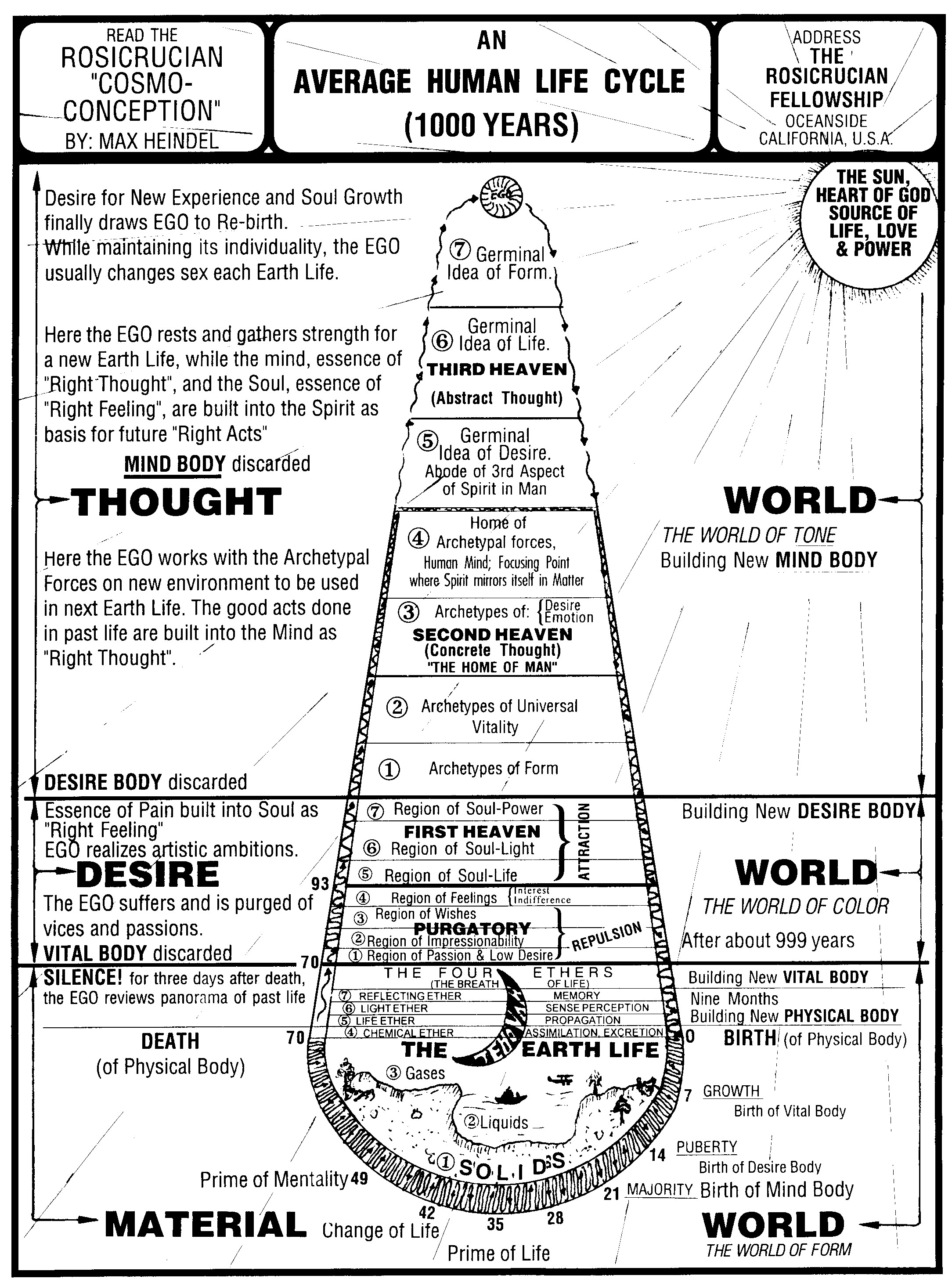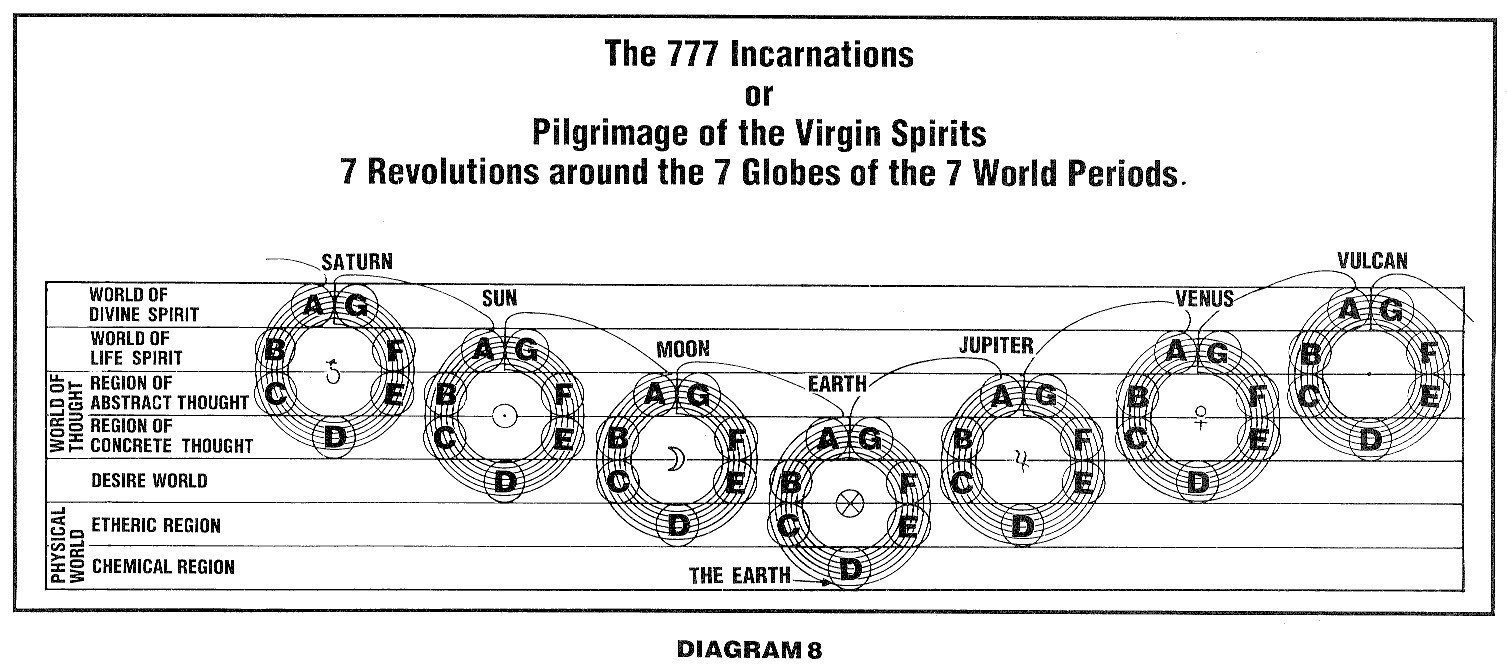
| rosicrucianU.com | ||
| Simplified Scientific Christianity |

The term "death" refers only to the form. The spirit is deathless. Also birth and death are relative terms: what we call death is in reality a birth into the spiritual world, and what we call birth is temporarily dying to the spiritual world.
When we have exhausted the possibilities of any particular life, it becomes necessary to pass on to higher spheres through the medium of the mistakenly dreaded process of dying. In the heart there is located what is known as the seed atom of the physical body. This seed atom is spoken of in Rosicrucian parlance as "The Book of God," because all the experiences of our past lives are inscribed upon it. This particular atom is permanent, and it will be taken with us through all our future existences, forming the basis of our individuality throughout all eternity. Death is brought about by the rupturing of the connection between this seed atom and the heart, after which the forces inherent in the seed atom together with the higher vehicles, namely, the vital body, the desire body, and the mind pass out through the top of the head. A connection, however, is maintained with the body by the silver cord for a period of about three and one-half days. The silver cord is threefold, one segment consisting of ether, one of desire stuff, and one of mind stuff, these segments being attached to the seed atoms of the corresponding bodies. The breaking of the connection between the dense seed atom and the heart causes the heart to stop beating, but the body is not yet dead, nor does it become so until the silver cord is broken.
At this stage a very important process is carried on, namely, the review of the panorama of the past life and the etching into the desire body of the pictures contained in this panorama. During life the reflecting ether of the vital body acts in the capacity of a sensitive plate, upon which are recorded all the thoughts, emotions, incidents, and surroundings of the life. The ether which is inspired with the breath carries these pictures, and through the medium of the blood they are impressed upon the vital body. They constitute the basis of the post-mortem experiences.
During a period of approximately three and one-half days after death the Ego is engaged in concentrating upon this panorama, unrolled before it in reverse order; that is, the incidents in the last part of life appear first in the panorama. If the concentration is clear-cut and not interfered with by noise or disturbance of any kind, the etching is deep and clear, and in the post-mortem life the Ego will be able to assimilate the full spiritual value of the life just completed. If, however, the Ego is disturbed by emotion, the weeping and wailing of relatives, or strife such as that of a battlefield, its concentration is destroyed, and the experiences of the past life are etched very lightly or not at all into the desire body. The result is that the past life is practically lost; namely, the spiritual qualities which normally should have been gained by it. We should therefore be very careful to surround the person who has just died with quiet conditions so that this panoramic retrospection may not be interfered with, as upon it depends the development of conscience and the incentive to right action for use in succeeding lives.
Another process which takes place simultaneously is the separation of the ethers. The two higher ethers, namely, the reflecting and light ethers, spoken of in the Rosicrucian philosophy as the soul body, separate at this time from the two lower, namely, the chemical and life ethers. They adhere to the higher vehicles and proceed with them through the higher worlds, acting as the basis of consciousness in those worlds, while the lower ethers remain with the body and disintegrate with it. If there is disturbance around the body during the life retrospection period, this cleavage between the ethers does not take place properly.
Administering stimulants to the dying is ill advised. It is productive of considerable pain to the Ego. The stimulants force the higher vehicles back into the body with a jerk and keep the person dying for hours and days when he might otherwise pass out with comparatively little distress. When it is clear that life cannot be prolonged beyond a few hours or days such stimulants should not be given.
After death the body should be placed in an ice pack for a period of not less than three and one-half days. Embalming should be avoided, because it interferes with the panoramic retrospection. Likewise cremation should be avoided during this period, because the Ego is still in connection with the body through the silver cord, and to a certain limited extent feels pain as a result of any mutilation of the body. Premature cremation dissipates the ethers and destroys the panoramic record which they contain. After this period of three and one-half days, however, cremation is advised, because it disintegrates the physical body and the two lower ethers with their residual magnetism, thus liberating the Ego into the superphysical worlds at once. In the case of burial the magnetism of the body and the lower ethers holds the Ego earthbound for a varying length of time, usually until decomposition has reached an advanced stage or been completed. This results in retarding the Ego for years in some cases.
If we know the facts about dying as determined by esoteric science, and utilize our knowledge, we may be of great service to those of our friends and acquaintances who pass over before us. Likewise, we may leave instructions so that when the time comes for us to slip our moorings, we shall have the same service performed for us.
(You are welcome to e-mail your answers and/or comments to us. Please be sure to include the course name and Independent Study Module number in your e-mail to us. Or, you are also welcome to use the answer form below.)
1. What is the real nature of death?
2. Describe the seed atom in the heart. What part does it play when we finally leave the body?
3. Describe the silver cord.
4. What is the life panorama, and how made? What function does it perform, and how is it preserved?
5. What conditions should be maintained around a person who has passed out, and why?
6. Describe the separation of ethers.
7. How should the body be cared for after the Ego has left it?

|

|

|
|
|
Contemporary Mystic Christianity |
|
|
This web page has been edited and/or excerpted from reference material, has been modified from its original version, and is in conformance with the web host's Members Terms & Conditions. This website is offered to the public by students of The Rosicrucian Teachings, and has no official affiliation with any organization. | Mobile Version | |
|